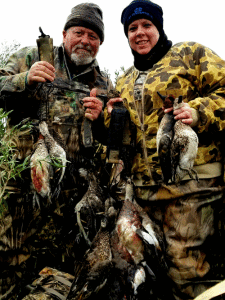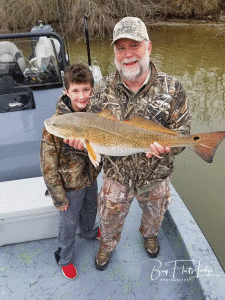
The Annual Sims Father and Daughter Duck Hunt was met with great success and already re-booked twice for next Season.
-Capt. Jeff Larson
Brrrrr! 2018! Do you ever remember being this cold of a winter? It’s safe to say that this winter was colder than last year’s winter. The good news about these Artic Blast is that it really brings the ducks down, Geese too. I just hope you have plenty of gear to stay warm.
Of course the down side to this years winter is it has killed so many fish. I am looking in my boat ramp, right now, seeing a bunch of dead mangrove snapper. Good eating size 1’s. Yes it is illegal to take dead fish off the water if anyone doesn’t know. If you get caught its the Game Warden’s discretion how he wants to handle the infraction. The only suggestions I can make is, be courteous to them and don’t have a cooler full. It would also look good If you were saving a few turtles. Better yet, don’t do it.
Let’s talk mid season and late season dux. We are definitely up in numbers this year, according to my records. I attribute it to a decent hatch, nice Big Cold Fronts and the mixture of Puddle Ducks and Drivers, P’s and D’s. However as of late, we have been killing more Puddlers than Divers. This means, I’m not having to run a large spread to get ducks on my straps. I have been concentrating on the smaller bodies of water or marsh ponds. This can usually be a feast or famine type of hunt but this year with good numbers of Pintails, Widgeon and Teal we have seen steady numbers. Oh Yeah! Shooting, Good Shooters make a big difference in the numbers for the Harvest Pose.
The other day, long time friends of ours at the Saltwater Lodge, Tony and Charlie Smythe along with Big John aka Mookie made their annual hunt with great success. These Gents are truly outdoorsmen who like savoring every moment of the hunt. It’s one of the most stress free hunts I have with a ton of laughs. Charlie applied a little pressure on me this year with a request for puddle ducks. As luck would have it that’s what we have been primarily shooting. To make sure that we shot puddlers, I found a smaller marsh pond to hunt. We stayed a way from the open bay water where the Divers dwell. It sure paid off, with great wing shooting, plenty of natural cover and puddle duck decs we smoked ‘em out and tilted the scale. The straps that day was loaded with some Awesome Bull Sprigs, Several Fat Lip’d Mallards, Greys and Ultra White Cotton Tops. Happy Happy Happy.
As the 2017 – 2018 Duck Season winds down to a close, we want to give a Big Shout Out to all the Groups that entered the Gates of the Lodge, Thank You! We hope that 2018 will be prosperous for you and pray for a safe return to the groups that are already re-booked.
Billy Ryhne is organizing and coordinating all of the Saltwater Lodge Outdoor Adventures so give him a call at 713 907 4796. He will hook you up, pun intended.
February Fishing is Combat Red Fishing Month which is a Reel Scream!
Captain Jeff Larson 281 217 0399


